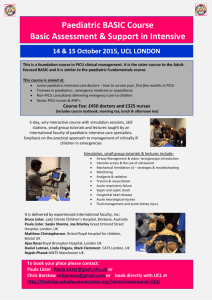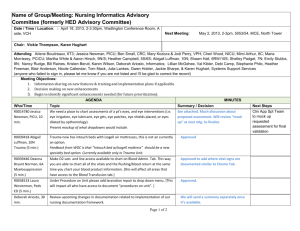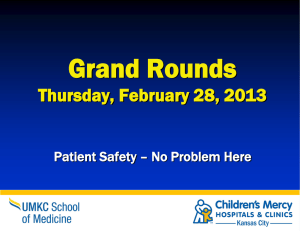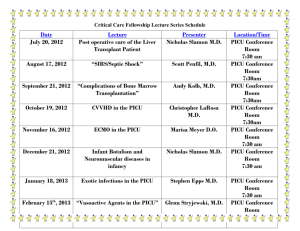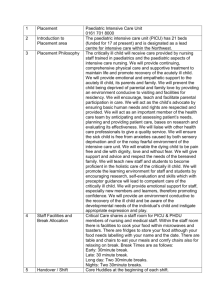IC/1 (P) FACTORS AFFECTING PARENTAL STRESS IN PEDIATRIC
advertisement
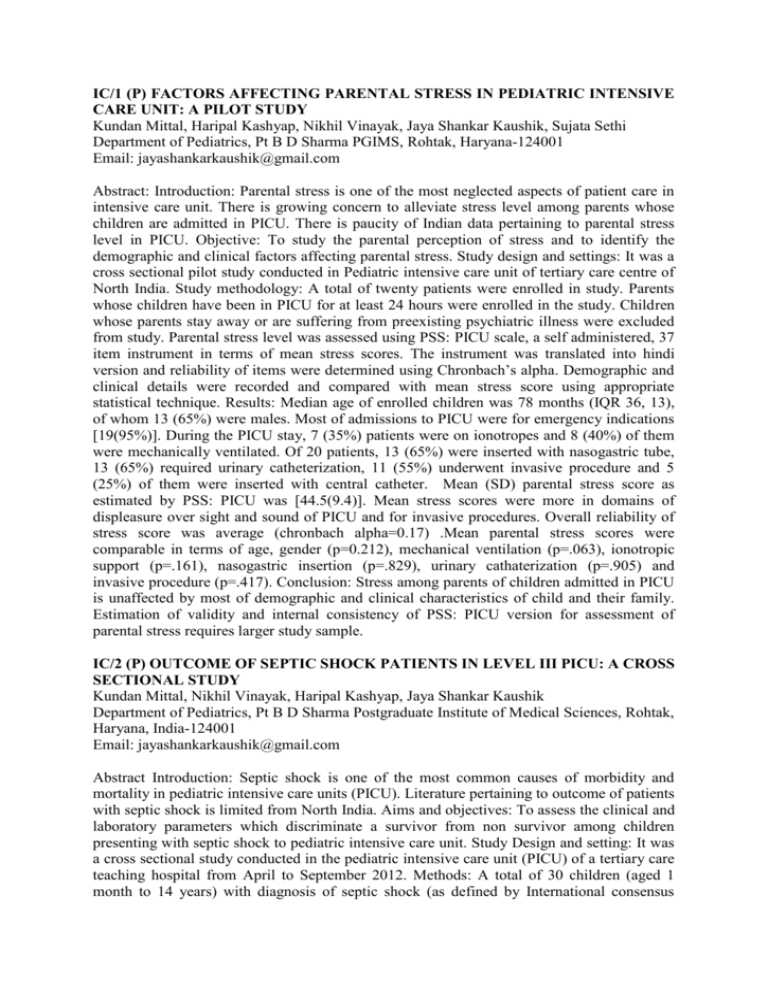
IC/1 (P) FACTORS AFFECTING PARENTAL STRESS IN PEDIATRIC INTENSIVE CARE UNIT: A PILOT STUDY Kundan Mittal, Haripal Kashyap, Nikhil Vinayak, Jaya Shankar Kaushik, Sujata Sethi Department of Pediatrics, Pt B D Sharma PGIMS, Rohtak, Haryana-124001 Email: jayashankarkaushik@gmail.com Abstract: Introduction: Parental stress is one of the most neglected aspects of patient care in intensive care unit. There is growing concern to alleviate stress level among parents whose children are admitted in PICU. There is paucity of Indian data pertaining to parental stress level in PICU. Objective: To study the parental perception of stress and to identify the demographic and clinical factors affecting parental stress. Study design and settings: It was a cross sectional pilot study conducted in Pediatric intensive care unit of tertiary care centre of North India. Study methodology: A total of twenty patients were enrolled in study. Parents whose children have been in PICU for at least 24 hours were enrolled in the study. Children whose parents stay away or are suffering from preexisting psychiatric illness were excluded from study. Parental stress level was assessed using PSS: PICU scale, a self administered, 37 item instrument in terms of mean stress scores. The instrument was translated into hindi version and reliability of items were determined using Chronbach’s alpha. Demographic and clinical details were recorded and compared with mean stress score using appropriate statistical technique. Results: Median age of enrolled children was 78 months (IQR 36, 13), of whom 13 (65%) were males. Most of admissions to PICU were for emergency indications [19(95%)]. During the PICU stay, 7 (35%) patients were on ionotropes and 8 (40%) of them were mechanically ventilated. Of 20 patients, 13 (65%) were inserted with nasogastric tube, 13 (65%) required urinary catheterization, 11 (55%) underwent invasive procedure and 5 (25%) of them were inserted with central catheter. Mean (SD) parental stress score as estimated by PSS: PICU was [44.5(9.4)]. Mean stress scores were more in domains of displeasure over sight and sound of PICU and for invasive procedures. Overall reliability of stress score was average (chronbach alpha=0.17) .Mean parental stress scores were comparable in terms of age, gender (p=0.212), mechanical ventilation (p=.063), ionotropic support (p=.161), nasogastric insertion (p=.829), urinary cathaterization (p=.905) and invasive procedure (p=.417). Conclusion: Stress among parents of children admitted in PICU is unaffected by most of demographic and clinical characteristics of child and their family. Estimation of validity and internal consistency of PSS: PICU version for assessment of parental stress requires larger study sample. IC/2 (P) OUTCOME OF SEPTIC SHOCK PATIENTS IN LEVEL III PICU: A CROSS SECTIONAL STUDY Kundan Mittal, Nikhil Vinayak, Haripal Kashyap, Jaya Shankar Kaushik Department of Pediatrics, Pt B D Sharma Postgraduate Institute of Medical Sciences, Rohtak, Haryana, India-124001 Email: jayashankarkaushik@gmail.com Abstract Introduction: Septic shock is one of the most common causes of morbidity and mortality in pediatric intensive care units (PICU). Literature pertaining to outcome of patients with septic shock is limited from North India. Aims and objectives: To assess the clinical and laboratory parameters which discriminate a survivor from non survivor among children presenting with septic shock to pediatric intensive care unit. Study Design and setting: It was a cross sectional study conducted in the pediatric intensive care unit (PICU) of a tertiary care teaching hospital from April to September 2012. Methods: A total of 30 children (aged 1 month to 14 years) with diagnosis of septic shock (as defined by International consensus definitions for pediatric sepsis) were consecutively enrolled in the study. Children with PICU stay less than six hours, those dying within 24 hours of admission, pediatric burns, and trauma patients were excluded from the study. Demographic, clinical and laboratory parameters of the patients were recorded. PRISM III score, number of organ failure and length of stay of all patients included in the study was computed and outcome was compared among survivors and nonsurvivors using appropriate statistical tests. Results: A total of 30 patients were enrolled in the study with median age of 33 months [IQR: 10.75, 67.50) and male to female ratio of 1.7:1. The median delay in transfer to PICU was 12 hours (IQR 5.75, 33.75). The mean (SD) PRISM III score at admission was 12.96 (8.09). The frequency of multiorgan dysfunction syndrome (MODS) was 80% (n=24) with mean (SD) number of organs involved being 2.83(1.51). All patients had high CRP titre (>10mg/l) and only one patient had culture proven infection. The nonsurvivors compared with survivors, had a higher mean prism score (16.11 ± 7.02 vs 8.84 ± 7.74, p value 0.012, 95% CI 1.73-12.81), had more number of organ dysfunction (3.58 ± 1.22 vs 1.84 ± 1.28, p=0.001, 95%CI 0.79-2.68) and had a shorter LOS [48 hours (IQR: 34, 92.5) vs 96 hours (IQR: 54,144), p= 0.029)]. The median age (p= 0.983), duration of delay to PICU (p= 0.074), duration of prior ionotropic (p=0.407) or ventilator (p=0.705) support, lactate ( p=0.15) and CPKMB levels (p=0.36) at admission were comparable among survivors and nonsurvivors. Conclusion: PRISM score and number of organ dysfunction could significantly affect outcome of children with septic shock in PICU. IC/3 (P) QUALITY OF CARE IN NICU OF PUBLIC & PRIVATE HOSPITAL – A COMPARATIVE STUDY Prashant Kini K, Shantaram Baliga B, Kiran N Baliga Department of Pediatrics; Kasturba Medical College; Manipal University Mangalore; Pin – 575001 India E-mail : kpkini@gmail.com. Abstract: Introduction: Hospitalization of child in neonatal intensive care (NICU) results in major stress for parents. To be able to spend time with their child in NICU, parents need to modify their lifestyle, while at same time attending to their other children1-2. Direct systematic comparisons of quality of care offered by public and private sector systems are lacking. Such evidence is needed to inform policies that seek to improve quality of overall care3. Aims & Objectives: Comparing perception of parents regarding quality of care provided in NICU of public and private hospital. Materials & Methods: Prospective hospital based study conducted with sample size of 50 cases in each NICU using pre-tested questionnaire (English & Kannada) to assess services provided under categories like quality of doctors, nurses and infrastructure. Results: Public hospital fared better than private hospital in categories like a) Length of time spent waiting (p=0.003, significant), b) Equipment (p=0.031, significant), c)Overall stay (p=0.11, significant) Private hospital was rated better in categories like a) Personal manner of physician (p=0.42, significant), b) Quality of physician (p=0.008, significant). Discussion:. Public hospital being one of its kind in state, with newly built infrastructure & facilities exceeded expectations of parents in terms of infrastructure & facilities. Parents of children admitted in ICU did not have any facilities for separate accommodation in hospital & had to be contented with common dormitory. Thus private hospital was rated better in categories like quality of physician, personal manner of physician. Key Words: neonatal intensive care, quality of care IC/4 (O) PROSPECTIVE STUDY OF VENTILATED PATIENTS IN A PEDIATRIC INTENSIVE CARE UNIT OF A TERTIARY CARE HOSPITAL FROM EASTERN INDIA Devdeep Mukherjee, Prabhas Prasun Giri, Agnisekhar Saha, Apurba Ghosh Institute Of Child Health, Kolkata. Email: devdeep_dm@rediffmail.com Introduction: There is an urgent need for pediatric critical care in order to provide better treatment to our children suffering from grave illness. Mechanical ventilation is an essential component of a pediatric intensive care unit. Objective: To determine the characteristics and outcome of ventilated patients along with the assessment of risk factors and prognostic indicators. Materials And Methods: 72 patients who were ventilated in our PICU from March 2011 to August 2012 were included. Children who were on ventilator for less than 6 hours were excluded. A detailed analysis was done of the demography, days on ventilator, cause of ventilation, organisms isolated from culture, drugs used, incidence of ventilator associated pneumonia and the outcome of patients. Results: 43% of the patients were in the age group of 1 month to 1 year. Male to female ratio was 1.67:1. The mean duration of ventilation was 5.95 days. 42 % patients were ventilated because of respiratory cause. Multi organ dysfunction syndrome accounted for 59% of deaths. Pseudomonas was isolated from 36% of culture positive patients. B lactam antibiotics were used in 73%. 47 % patients required vasopressors while on ventilation.17 % developed ventilator associated pneumonia.17 patients died after being ventilated. Conclusion: Male children were ventilated more frequently. Most common cause of ventilation was pneumonia/ARDS. MODS was the most common cause of death. Pseudomonas was the most commonly isolated organism. Early isolation of organisms decreased the duration of treatment. Most of the deaths occurred between 6 hours and 16 hours of hospital admission as the patients were admitted late. IC/5 (O) PREVALENCE AND OUTCOME OF SEPSIS INDUCED MYOCARDIAL DYSFUNCTION IN CHILDREN WITH SEPTIC SHOCK Aditi Jain, Jhuma Sankar, Dinesh Yadav, Anubhuti, NK Dubey Department of Pediatrics, PGIMER, DR RML Hospital, New Delhi; Email: dr_nkdubey@yahoo.com Abstract: nIntroduction: Septic shock commonly affects the cardiovascular system to produce Sepsis Induced Myocardial Dysfunction (SIMD). Aims and Objectives: (a) To estimate the prevalence of SIMD by echocardiography and cardiac troponin I (cTnI) in children with septic shock and (b) to assess the effect of this SIMD on clinical course and outcome immediately and at 3 months. Materials and Methods: Echocardiography and cTnI levels were done in children with septic shock (Group-1, n=31) and sepsis (Group-2, n=30) in the first 48 hours of admission. Myocardial dysfunction was defined as systolic (abnormal Ejection Fraction) and/or diastolic (abnormal E’ and Myocardial Performance Index) dysfunction. Fluid, inotrope and ventilation requirements, and outcome (death/discharge) were compared between children with septic shock with and without myocardial dysfunction. Echocardiography was repeated after 3 months in survivors. Results: Prevalence of myocardial dysfunction (n=22, 71%) particularly diastolic dysfunction (45.2%) was higher in children with septic shock compared to those with sepsis (n=7, 23%). cTnI showed poor sensitivity (62.5%) and specificity (55.1%) and was equally raised in both groups. Children with septic shock and myocardial dysfunction had a higher requirement for dobutamine (p=0.023) than those without. Fluid and ventilation requirement, duration of PICU stay and outcome were not affected by the presence of SIMD. SIMD resolved in most patients (71.3%) at 3 months. Conclusion: Prevalence of SIMD is high in children with septic shock. cTnI does not correlate with the degree of SIMD and may be used as a supplement to echocardiography only. Keywords: Diastolic dysfunction; systolic dysfunction; sepsis induced myocardial dysfunction, SIMD; Troponin-I, cTnI IC/6 (O) RELIABILITY OF URINARY MICROALBUMIN INFLAMMATORY MARKER IN THE CRITICALLY ILL CHILD Biplab Maji, Surupa Basu Institute of Child Health, Kolkata, India Email: dr.biplab.maji@gmail.com AS AN Introduction: Microalbuminuria is considered to be the glomerular component of systemic capillary leakage that occurs in systemic inflammatory response syndrome (SIRS), a common finding in critically ill patients. The assay is simple, non-invasive, inexpensive and a bedside test. We wanted to assess its reliability as an inflammatory diagnostic and prognostic marker in the sick child. Objectives: 1.Assess efficacy to predict the severity and course of inflammation by correlation with established inflammatory markers. 2. Evaluate its potential to predict organ dysfunction and outcome. Study Design: Prospective observational study Setting: Paediatric intensive care unit of a tertiary care hospital. Materials and methods: Microalbuminuria reported as Albumin Creatinine Ratio [ACR (µg: mg)] on random urine collected on day1 and day 3 of PICU admission. Parallel estimations on blood for CRP, ESR and TLC, day 1 PELOD scores, morbidity (vasopressors, mechanical ventilation and dialysis hours) and outcome (length of hospital stay, mortality) were noted. Children with anuria, dipstick + blood and/ or > 1+ proteinuria, pre-existing renal disease, urinary tract infection or on vasoactive drugs were excluded. Results: In 32 children (median age 5 yrs, 68% male) recruited between May – Aug 2012, significant microalbuminuria was observed [median day 1 ACR 75.1 mg/g (IQR 42. 3- 105.0)] in 90% of the population that was positively associated with SIRS. ACR significantly correlated with PELOD scores [median score 13] (P<0.05). However, no significant associations were obtained with CRP (p= 0.725), ESR (p= 0.614) or TLC (p=0.264). Conclusion: Microalbuminuria is a common finding in the PICU and predicts organ dysfunction. Preliminary data of this ongoing study reveals its yet unexplored potential as a prognostic marker in the pediatric intensive care setup. Key words: SIRS, PICU, Urinary micro albumin, ACR, inflammatory markers, capillary leakage
